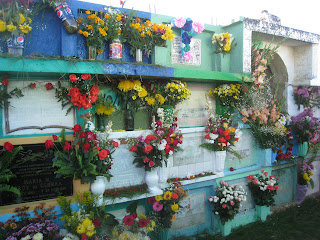I'll admit it; I can be a bit of a Grinch back home when it comes to Christmas. I just feel like it's become such a poisoned holiday, such a circus, that I find myself waiting impatiently for the day to come so it can be over and we can all resume our lives, free of gems like "Santa Baby." Don't get me wrong, I do love my family's traditions--Chinese food and midnight church on the 24th, gifts at midnight, a relaxed lasagna lunch with the whole family on the 25th. And no matter where in the world I am, I usually end up mimicking these very traditions--I enjoyed a lovely Chinese food dinner with some PCV friends in the city, and am planning a post-New Years lasagna feast for the local family who was kind and generous enough to share their Christmas Eve with me.
On Wednesday I took Dilan and his three-year old cousin Cristien to the market to see Santa. It was horribly crowded but we managed to make our way towards the front of the crowd. And there danced Santa, inside the pharmacy, in all his cheesy red-suited glory. Dilan and Cristien were pretty unfazed by the whole thing and seemed more interested in the ice cream cones I had bought them than Guatemalan pharmacy Santa. I've always wondered how and if Santa Claus works his way into places such as rural Guatemala. Dilan helped me solve this mystery. He asked me that day if Santa had ever visited me. I told him that yes, when I was a little girl, Santa would come and leave my sister and I presents. He seemed excited about this. "Santa's never come to our house but my mom says that's because he lives too far away. But once the Catholic nuns brought in Santa and he walked around giving all the kids bags of candy." So there's my answer. Santa exists to Guatemalan kids, although in a more far-off way. Rural Guatemala is a bit too far away for Santa and his sleigh, and there are no chimneys for him to magically shimmy down. Dilan will still receive a Christmas present or two--his mother got him some new clothes for when he starts school in January, and I got him and his brothers some new school supplies (thanks to some great care packages from people back home!) But that's not what Christmas is about here. It's not about a stupid fat white man in a red suit or iPhone 5's. It's about family, good food, and, of course, fireworks.
For the 23rd Zurma, an eight-year old neighbor girl who comes over almost daily to do workout videos with me, invited me to come see her perform in the Chrismas pageant at the local church. So I went to the church where I sat through a four-hour long Christmas service led mostly by the children of the congregation. It was actually pretty entertaining, and I got a Christmas tamale out of the deal (although not until 11:30pm when the service ended). During the closing prayer, which I noticed Pastor Isabel did in Spanish, she asked everybody present to pray for me and my family far away in the United States. All around me I heard murmured Q'eqchi' blessings for "Qana Jana ut li junkaba'al," and I was truly touched. All week long people have been inviting me to spend the holiday with their families, to come watch the pig be slaughtered and to learn how the famous Christmas tamales are made. Locals have always been concerned that I live out here alone, without my family, or a husband, or anybody else to take care of me. But this Christmas they've all been especially concerned that I have a family to spend Christmas with, that I eat many tamales, and that I talk to my family back home. Nothing and nobody can replace my family back home, but these folks sure do a pretty good job at taking care of me and making me feel loved.
| The kids singing a song on the 23rd. Cristien and Dilan were the "U" and "C." |
| The Christmas Eve feast: tamales, fruit, bread, tostadas, and ponche (basically hot fruit coctail). |
 |
| Naomi and her brothers ready for the feast! |
















